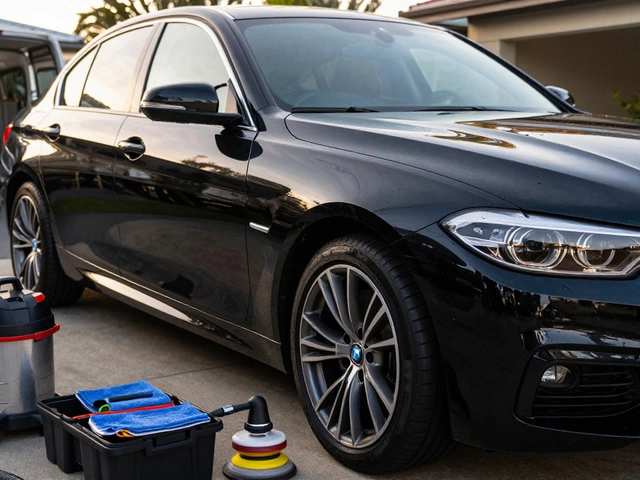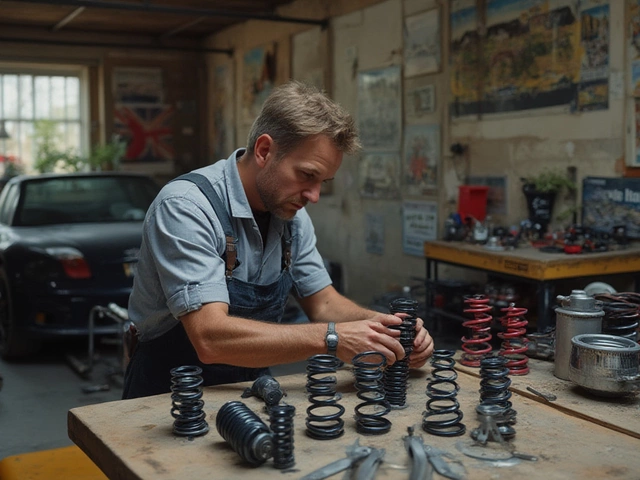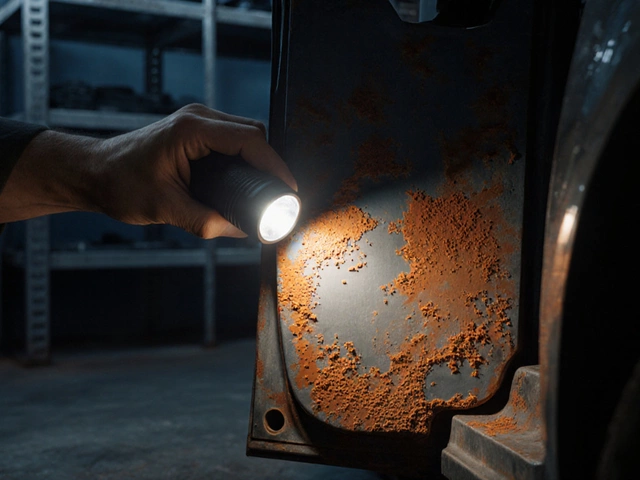Ever stood next to a car that made your bones rattle with its deep, growling roar? That right there might be the work of a beautifully aggressive muffler. A good muffler isn't just about noise; it's about making the kind of noise that turns heads for the right reasons. But what exactly makes one muffler sound more aggressive than another? Let's kick things off with the basics of muffler construction—it all starts with what's inside. Some mufflers use chambers, others straight-through perforated tubes, and then there are the glass packs that hold their own in the world of loudness.
So, why should you care about muffler design? Because it directly impacts not just the sound but also your car's performance. A well-chosen muffler can help you strike the perfect balance between a satisfying growl and optimal engine efficiency. It's like finding that sweet spot with your morning coffee—not too bitter, not too weak, but just right.
When it comes to selecting the loudest or most aggressive sounding option, you've got choices like Flowmaster's Super 10 Series, Borla's ATAK, or the ever-popular Cherry Bomb. These names are legendary for a reason, but each has its personality and noise signature. And the beauty of customizing your exhaust is that it’s an individual journey—you’re crafting your vehicle’s voice, after all.
- Understanding Muffler Basics
- The Science of Sound
- Top Aggressive Muffler Choices
- Installation Tips and Tricks
- Legal Considerations
- Maintenance for Longevity
Understanding Muffler Basics
When it comes to car mufflers, a lot more is going on under the hood than you'd think. So, what's happening in that metal canister that packs the power to alter your car's growl? At its core, a muffler's job is pretty straightforward: to manage the noise that comes from your engine's exhaust.
Mufflers are all about precision engineering. They're not just about loudness; they're about sound quality and control as well. Most mufflers use one of three main designs: chambered, turbo, and straight-through. Each has its unique way of altering and tuning sound.
Chambered Mufflers
Chambered mufflers have interior chambers that bounce sound waves back and forth, canceling each other out to reduce noise. They're known for producing that classic muscle car rumble. The Flowmaster Super 40 is a prime example, offering a deep, aggressive sound.
Turbo Mufflers
Turbo mufflers feature a series of perforated tubes that redirect exhaust gases and sound waves. They offer a good mix of performance and sound, creating a more subdued tone. They're like the middle ground in the muffler world, providing some aggression without going overboard.
Straight-Through Mufflers (Glasspack)
Straight-through mufflers, often called glasspacks, allow exhaust gases to flow with minimal restriction. They usually have a single, perforated tube packed with sound-absorbing material, like fiberglass. The Cherry Bomb is a legendary example, and it’s designed for those who want to turn the volume up to eleven.
"A muffler can change your car's sound from mere background noise to a distinctive growl," says Jason Fenske of Engineering Explained, highlighting its role in personalizing vehicle sound.
Why does this matter? Think about your goals with your car's sound. Are you aiming for something subtle or the loudest roar on the block? Your choice of muffler design will directly influence that. In fact, a survey by Street Car Magazine found that 65% of car enthusiasts prefer a custom exhaust specifically for its ability to personalize their driving experience.
| Type | Sound Level | Performance Impact |
|---|---|---|
| Chambered | Moderate to Loud | Mid-range boost |
| Turbo | Quiet to Moderate | Mild boost |
| Straight-Through | Very Loud | High performance |
Picking the right muffler boils down to balancing your need for sound with your need for speed and efficiency. Choose wisely, and your car won't just sound faster—it may actually be faster!
The Science of Sound
So, what makes a muffler truly roar? It all comes down to how sound waves travel and resonate within the exhaust system. At the heart of an aggressive muffler is its ability to manage these waves. Picture this: sound waves are like ripples in a pond, and the design of the custom exhaust system determines how intense those ripples get.
The secret sauce lies in the internal structure of the muffler. Some go for the chambered design. This setup uses internal partitions to reflect sound waves back on themselves, canceling out certain frequencies while enhancing others. This gives that rich, deep rumble that's unmistakably aggressive. On the flip side, straight-through designs focus on minimizing resistance to exhaust flow, providing a free reign for sound waves, resulting in an unfiltered growl.
Resonance and Frequency
Resonance is a big player here. The more a muffler allows sound waves to bounce in harmony, the more profound the effect on perceived loudness. It's like hitting that perfect note on a piano—when everything lines up, it’s pure magic. Low-frequency sounds—the kind most people associate with power—are often amplified in this way, giving off that feared yet admired growl.
Materials Matter
Let’s talk materials. Different metals or alloys don’t just impact durability—they change how sound is produced too. Stainless steel, often found in top-performing loud exhaust systems, flexes slightly under pressure, which helps in transmitting clear, pure sound without distortion. Meanwhile, mild steel might not last as long but can offer a unique tonal quality that some drivers love.
Fun Fact
Did you know that some racing enthusiasts will even go as far as tuning their pipes to specific lengths? It’s all about hitting those sweet acoustic points that resonate perfectly for maximum effect.
Understanding these elements isn't just for the noise; proper sound management can improve your vehicle's performance, too. A well-designed exhaust system helps an engine 'breathe' better, often translating to increased horsepower. So, you’re not just making noise; you’re optimizing your ride’s performance.
Top Aggressive Muffler Choices
Choosing the right aggressive muffler can transform your ride from a whisper-quiet cruiser to a mean, growling machine. Certain brands have gained reputations in the car enthusiast community for delivering that standout roar, so let's dive into what the big players offer.
Flowmaster Super 10 Series
If you're aiming for unparalleled thunder, the Flowmaster Super 10 Series is often the top pick. It's built for a deep, throaty sound that turns heads and demands attention. Designed with the race track in mind, it's one of the loudest options available under the Flowmaster brand.
Flowmaster’s patented Delta Flow Technology reduces metal resonance and promotes maximum efficiency. The compact size of the Super 10 makes it easy to fit in various setups, which is a big win for those customizing on tight spaces.
Borla ATAK
Borla's ATAK (Acoustically Tuned Applied Kinetics) is all about precision. This aggressive muffler is engineered to provide the loudest and most aggressive sound of any Borla product while maintaining clarity and avoiding unwanted droning inside the vehicle.
The ATAK system's multi-core technology ensures not just sheer noise, but a nuanced blend of aggressive acoustics. It's the go-to for folks who want their exhaust to scream performance without compromising on tonal quality.
Cherry Bomb Glasspack
A name synonymous with loud and proud vehicles, the Cherry Bomb Glasspack is an iconic choice. This classic design has been a favorite since the 1960s, delivering a raspy, racetrack-inspired sound that never goes out of style.
Its straight-through design minimizes back pressure, giving it that unmistakable rumble. Cherry Bombs are known for their affordability and ease of installation, making them accessible for both beginners and seasoned DIYers.
Dynomax Race Bullet
The Dynomax Race Bullet muffler might be smaller in size, but don't let that fool you. It's all about producing maximum sound with minimal restriction. The Race Bullet's straight-through construction ensures optimum flow, enhancing power and providing an unmistakable performance-enhancing growl.
| Brand | Volume Level | Distinctive Feature |
|---|---|---|
| Flowmaster Super 10 | Very Loud | Delta Flow Technology |
| Borla ATAK | Loud | Clarity |
| Cherry Bomb Glasspack | Moderately Loud | Classic Rumble |
| Dynomax Race Bullet | Loud | Optimize Flow |
Choosing the right muffler is all about personal preference and considering the setting where you'll be driving it. From loud exhaust options like the race-ready Flowmaster Super 10 to the refined rumble of Borla's ATAK, each offers its character and charm. Just make sure it aligns with local noise ordinances to keep everything street legal.

Installation Tips and Tricks
So, you've got your hands on an aggressive muffler and you're itching to get it installed. Here's the lowdown on making sure everything goes smoothly.
Preparation is Key
Before diving into the installation, make sure you've got all the tools ready. You'll typically need a jack, jack stands, a wrench set, and possibly some lubricant to ease the removal of old parts. A can of WD-40 can be your best friend here—rusted bolts are way more cooperative with a spritz or two.
Step-by-Step Installation
- Safety First: Get that car up on jack stands and make sure it's stable. There’s no shame in being extra safe.
- Remove the Old Muffler: Start by loosening the bolts on the clamps holding your old muffler. Apply some lubricant if they’re stubborn. Gently remove the hangers holding the muffler in place.
- Fit the New Muffler: Slide your new aggressive muffler into position. Align it properly with the existing pipes, ensuring everything lines up before tightening anything.
- Tighten the Clamps: Once you’re happy with the positioning, tighten the clamps. Pro tip: Start the car briefly to check for any leaks before finalizing.
- Secure the Hangers: Make sure all the hangers are secured tightly. A loose muffler can lead to some unpleasant noise and vibration.
Extra Tips
- Always double-check the manufacturer's instructions. Different models might have unique requirements.
- If you’re switching to a muffler like the Cherry Bomb, remember that not all setups are street legal in every state. Best to check local laws before you rev up.
- After installation, take your car for a spin to ensure everything sounds just like you wanted. If there are any weird noises, head back underneath to tweak.
Installing an aggressive muffler isn't rocket science, but it requires some time and patience. And hey, if things get tricky, don't hesitate to reach out to a pro. Saving a buck is great, but peace of mind is priceless.
Legal Considerations
So you're thinking about cranking up your ride's sound with the most aggressive muffler? Cool, but hang on a second. There's more to consider than just how it'll sound. No one wants a ticket, right?
Know Your Local Laws
This is super important. Laws around vehicle noise can vary a lot depending on where you live. In some places, the laws strictly regulate the decibel levels your car can produce. Look up your state or country's vehicle noise regulations before you make any mods.
For instance, in California, the law mandates that car mufflers can't exceed 95 decibels. Trust me, if you skip this step, you might end up with a hefty fine and have to undo all your hard work.
State Inspection Rules
Many states require regular inspections, and too loud an exhaust can cause your car to fail. This might mean you have to reinstall the stock exhaust temporarily to pass the inspection, which is a hassle.
Insurance Impacts
Did you know some insurance providers may have rules about modifications? Your insurer might see a loud exhaust as a potential risk. It's worth a call to check if modifying your custom exhaust affects your premiums. Better safe than sorry!
Respect the Neighbors
We all love that powerful exhaust note, but your neighbors might not. Consider the community noise levels as well. No one wants to be that guy waking everyone up at 6 in the morning with a roaring ride.
Remember, with these custom exhausts, it's not about causing a scene, but enjoying the right kind of attention. With a bit of research and consideration, you can have both your dream sound and peace of mind.
Maintenance for Longevity
Keeping your custom exhaust system in top shape doesn't have to be a chore, but it does take some routine care. Start by performing regular inspections. This means checking for any rust or corrosion, especially if you live in places with harsh weather conditions or if you drive on salted roads. A visual check every few months can save you from expensive replacements down the line.
Next, there’s the issue of cleaning. Exhaust builds up grime and gunk over time, which isn't just unsightly but can also affect performance. Use a soft brush and soapy water to clean the exterior, but avoid using harsh chemicals as they can damage the coating on some mufflers. Consider using a metal polish every now and then to keep things shiny.
"When it comes to muffler maintenance, prevention is key. Regular care not only maintains performance but also extends the life of your loud exhaust," notes car expert Jay Leno in an interview with Auto Weekly Magazine.
Then, of course, there's tightening the connections. Vibrations from driving can loosen up the clamps and connections, so make sure everything is snug. Give your exhaust system a gentle shake; if you hear any rattles, it's time to get those tools out.
Pro Tips
- After washing your car, pay extra attention to drying off your exhaust to prevent moisture from sitting and causing rust.
- Consider investing in a rust prevention spray if you're frequently dealing with moisture-heavy conditions.
- When selecting parts for your aggressive muffler, opt for stainless steel materials—they're more resistant to rust and corrosion.
Finally, don't forget about professional check-ups. A mechanic can spot issues that may not be visible to the untrained eye. Consider an annual check to ensure everything's in great shape.






